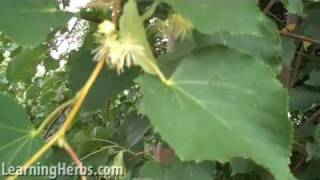Sunday, 11 January, 2026г.
















Где искать: по сайтам Запорожской области, статьи, видео ролики
пример: покупка автомобиля в Запорожье
Small-leaved lime (Tilia cordata) - frozen bud - January 2018
Small-leaved lime is a deciduous tree native to the UK and across Europe. It is very similar to the Common lime and the Large-leaved lime.
Tilia cordata is a deciduous tree growing to 20–40 m (66–131 ft) tall, diameter 1/3 to 1/2 the height, with a trunk up to 1 m diameter. The bark is smooth and grayish when young, firm with vertical ridges and horizontal fissures when older.
The crown is rounded in a formal oval shape to pyramidal. Branching is upright and increases in density with age. The leaves are alternately arranged, rounded to triangular-ovate, 3–8 cm long and broad, mostly hairless (unlike the related Tilia platyphyllos) except for small tufts of brown hair in the leaf vein axils - the leaves are distinctively heart-shaped.
The buds are alternate, pointed egg shaped and have red scales. It has no terminal bud. The small yellow-green hermaphrodite flowers are produced in clusters of five to eleven in early summer with a leafy yellow-green subtending bract, have a rich, heavy scent; the trees are much visited by bees to the erect flowers which are held above the bract; this flower arrangement is distinctly different from that of the Common Lime Tilia × europaea where the flowers are held beneath the bract.
The fruit is a dry nut-like drupe 6–7 mm long by 4 mm broad containing one, or sometimes two, brown seeds (infertile fruits are globose), downy at first becoming smooth at maturity, and (unlike T. platyphyllos and also T. x europaea) not ribbed but very thin and easily cracked open.
Lime leaves are eaten by the caterpillars of many moth species, including the lime hawk, peppered, vapourer, triangle and scarce hook-tip moths. They are very attractive to aphids, providing a source of food for their predators, including hoverflies, ladybirds and many species of bird (bees also drink the aphid honeydew deposited on the leaves). The flowers provide nectar and pollen for insects, particularly bees.
Long-lived trees provide dead wood for wood-boring beetles, and nesting holes for birds.
Lime wood is soft and light, white-yellow and finely textured. It is easy to work and often used in turnery, carving and furniture making. Lime bark was traditionally used to make rope, and lime flowers were considered a valuable source of food for honey bees. The wood does not warp and is still used today to make sounding boards and piano keys.
Limes can be coppiced and used for fuel, hop-poles, bean-sticks, cups, ladles, bowls and even Morris dancing sticks.
The young, translucent leaves of limes are edible. They can be cooked, but are best eaten raw, added to salads or sandwiches instead of lettuce.
Теги:
nature Exeter trees shrubs plants Clyst St Mary EX5 1SA jacks way blackmore road stuart way musroom road a3052 A3052 Hill Barton industrial estate lime small leaf lime small leaf tree lime tree European basswood basswood European lime Russian bast tree linden tree Malvaceae common linden Malvales Tilia cordata T. cordata little leaf lime little leaved lime small lime littleleaf linden small-leaved linden linden
Похожие видео
Мой аккаунт


 У вашего броузера проблема в совместимости с HTML5
У вашего броузера проблема в совместимости с HTML5


